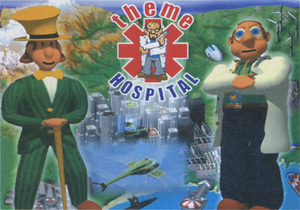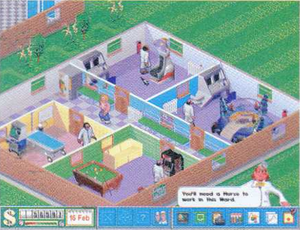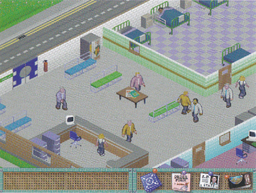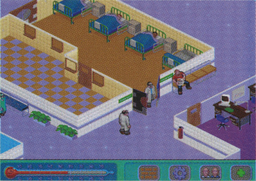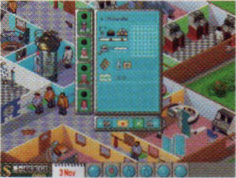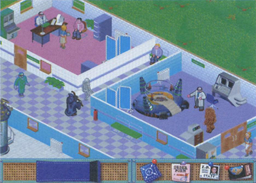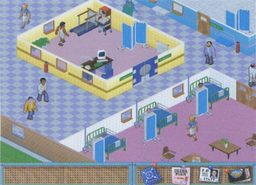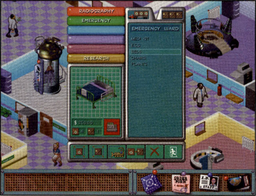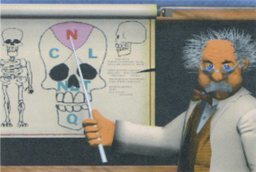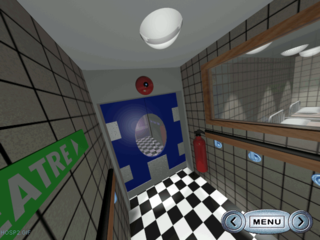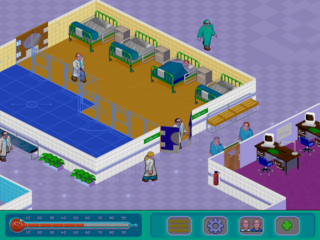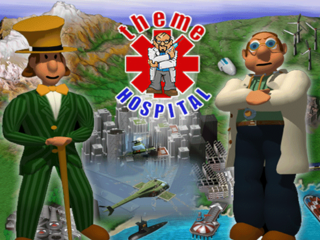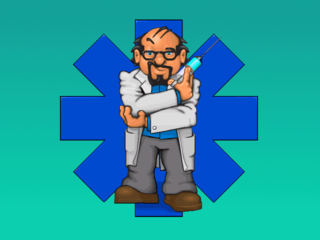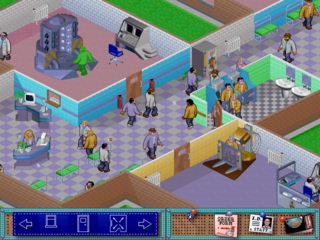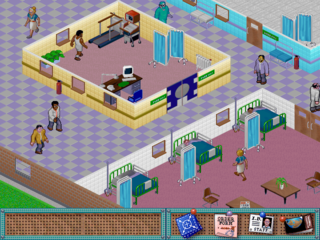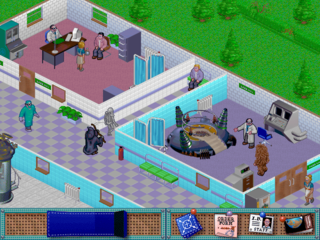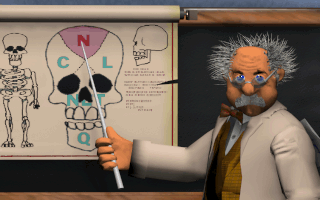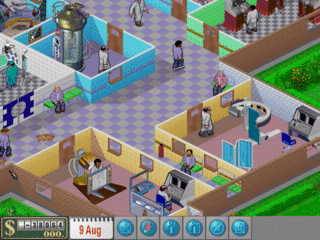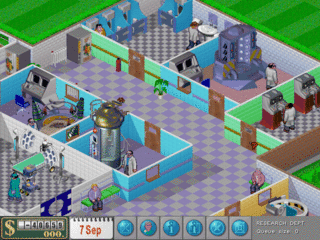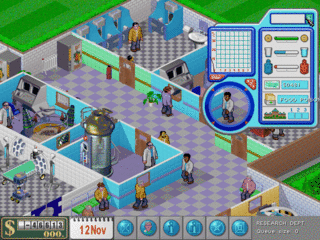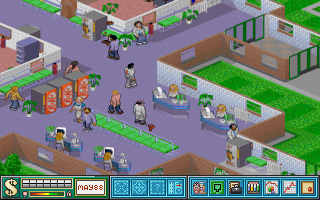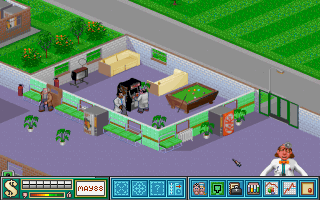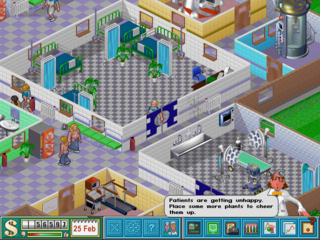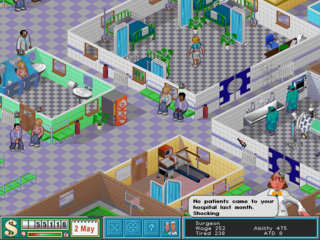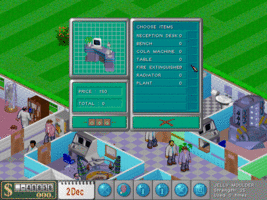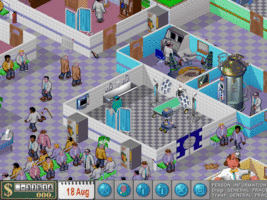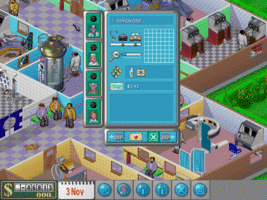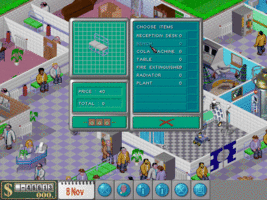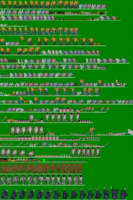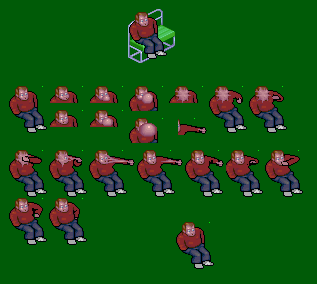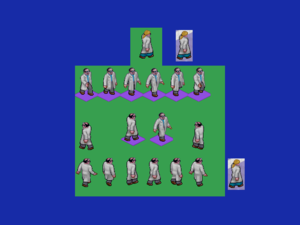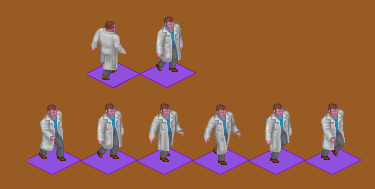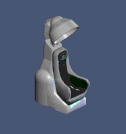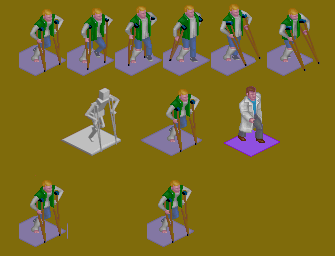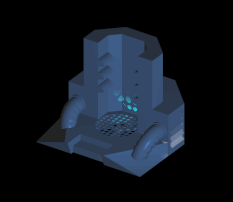Prerelease:Theme Hospital
This page details pre-release information and/or media for Theme Hospital.
| To do: Translate the French magazine articles and see if there's anything worth putting on here. |
Theme Hospital underwent numerous changes during its development, most notably the change of focus from a real hospital to comical ailments, and the dropping of the planned different time periods the game would have been set in. The game's release date was also pushed back multiple times.
Contents
Development Timeline
- Late 1994/early 1995 - After much research, it was decided that the game would feature made-up illnesses rather than real ones.[1][2][3]
- 1996
- 1997
- The game was set for release on 27 March.[6]
1995
There was difficulty in basing the game on real hospitals because the developers knew that theme parks are naturally much more colourful and fun than hospitals.[1] After hospital visits, this idea was dropped and the game shifted to using comical ailments instead.[1][2][3]
A promotional trailer for Bullfrog games purportedly from 1996 includes brief glimpses of the very earliest build of the game. This shows a doctor doing his rounds in a ward, and bringing up a cut chart for each patient at their bed.
The game was shown in a Bullfrog Progress report, and featured the adviser from Theme Park. Much progress had been made on the artificial intelligence.
A trailer advertised the intended four time periods, and showed other stuff not in the final game, and claimed a release date of Spring 1996 (May 1996, according to Bullfrog as of late 1995/early 1996[7]).
A 1995 promotional release showed the game with doctors, floor designs, and other things not seen in the final game.[8]
1996
Some magazines, including Génération 4 and Bullfrog's own publication Bullfrog Bulletin, were showing promotional images with the Theme Park adviser.[9][10] The third issue of Bullfrog Bulletin claimed a Summer 1996 release date.[11]
The game was originally to have four time zones: modern, mediaeval, futuristic, and Victorian.[2][3] The intention was for the player to begin in the mediaeval zone and progress through them.[12] By May 1996, this had turned out to be "prohibitive" because of the number of graphics required.[4] PC Zone speculated that this feature would come in an add-on disc or sequel.[4]
Issue 72 of the French games magazine Joystick from June 1996 included several videos of Bullfrog games on its cover CD. A video of Theme Hospital shows the third iteration of the UI being put through its paces, including otherwise unseen glimpses of its room item and staff UIs and some very different looking staff portraits compared to any other version of the game.
A non-playable 1996 demo demonstrated game editors and other stuff not in the final game. The date and balance are at the top-left corner of the screen.
An official "Theme Hospital Diary" was written by Bullfrog's Mark Webley for the UK GamesMaster magazine in late 1996. Running for only 3 issues (45-47), the articles are not very illuminating, but the final instalment does briefly discuss the cut alien invasion event that seemingly only remains as unused receptionist announcements in the final game:
"The team want aliens now. Fleets of nasties to destroy, maim and pass around nasty rashes to the population. But surely introducing aliens to the game is overkill? No actually, if your hospital is running well enough there's no reason why you wouldn't be able to cope with an alien invasion."[13]
1997
By early 1997, the game was mostly complete. Release was set for 27 March.[6]
Other Changes
- There was to be a feature that let players mix coloured chemical to create their own cures by testing them on "human guinea pig patients".[2][9] It was scrapped because it "didn't work well with the rest of the game".[2]
- King Complex was originally called Elvis Impersonator. The name was changed for legal reasons.[2][3]
- The game started with a lot of borrowed code from Theme Park, but by the time it was released most of it had been rewritten.[14]
Preview screens from magazines show numerous differences between development versions and the final:
A patient with different attire, a completely different interface, a surgeon outside the operating theatre, a table in the corridor, a room blueprint blocking a door, what appears to be a combined GP's Office and General Diagnosis, and what appears to be a store cupboard. There's also a fire extinguisher that appears to be hanging on the wall, which does not happen in the final game.
(Source: Bullfrog Bulletin issue 2 page 8)A different and much more complex Hospital Policy page. This version implies the financial side of the game was much more complicated as it was possible to reject patients paying via insurance/certain providers, as well as automatically "researching" uncurable patients and choosing what kind of drugs to give to patients.
(Source: PC Zone issue 46 January 1997 'Everything You Wanted To Know About Theme Hospital' Supplement page 16)
A trailer for the game claimed a release date of December 1996, and showed a helicopter exploding.
Press Pack Images
Found on the internet is a "preview" archive of official Bullfrog screenshots of their games in development in 1995/96, including Dungeon Keeper, Theme Hospital, Syndicate Wars, Creation, and others. These early screenshots were printed in all the videogame magazines at the time, and seem to be the original source of many of the images above. These pictures show the game in many different stages of development, including what are clearly extremely early versions of the game. The archive consists of a directory full of these images in various formats for each game, and a second "catalog" DOS executable that contains more images and basic explanatory text.
"Catalog" Program Images
This is a DOS executable called "View" that is some kind of generic interactive manual viewer created by Bullfrog. This program contains a short brochure of further images and information on Bullfrog's games from the era, including three very early images of Theme Hospital. Unfortunately the raw pictures inside the .dat files have the menu buttons actually written onto the image itself, they are not an overlay that can be removed.
What seems to be a screenshot of the first iteration of the game. This is very similar to the screenshot printed in Edge 22 but with slightly different NPC positions and the dividing wall (which is not possible in the final game) in the room not yet placed. There is also what appears to be a female doctor, a doctor with a different head design not in the final game, a pair of orderlies carrying a stretcher, and a wall chart. None of these are in the final game. Room entrances also have room placards outside them.
Promotional Images
A handful of images showing characters and logos from the Press Pack. Presumably the Theme Park branding angle was going to be pushed harder at one point, as evidenced by the Advisor dressed in his original costume in the rolling demo files.
Another image with the Theme Park Advisor. The three faces in the middle are very similar to what is used in the final game for load screens, but with the Advisor redone wearing his Doctor costume in the final game. The woman pictured in the scanner is wearing a different set of undergarments compared to those used in the final game.
"Pin Board" Build Images
These images all show a build of the game with an early UI design based around notes pinned to a cork board.
Source image for a picture printed in Génération 4 June 1996 issue above. The ward here has cut tables with plants and a newspaper on them. There are also screens in front of each bed of a design not seen in the final game. There is also what appears to be a combined GP office/Cardio room. The placards from the earliest build exist on the walls or room entrances here still.
Source image for another picture printed in Génération 4 June 1996 issue above. There is a nurse administering medication in what appears to be a joint Pharmacy and GP's office. In the final game this can't happen as each room can only have one purpose. The electrolysis machine also has a general diagnostic cart and screen inside it, and a placard inside the room.
Source image for a picture from PC Zone issue 38 above. The interface for room objects is totally different. Note that this is for an Emergency Ward", a room that does not exist in the final game. There are also "ECG" and "Medikit" objects that are not in the final game. The bed pictured also has some of statistics against it, one represented by a box with a medical cross on it, the other a crate with a note on it. It's not clear what these represented.
"Curved" Build Images
These images all show a build of the game with a UI design based around circular icons. That there's now a balance counter and calendar at the bottom left of the screen much like the final game suggests this was a later iteration.
Near Final Build Low Res Images
A pair of screenshots of the low resolution mode of a near-final build. The interface is now very close to the final build, only the balance counter doesn't seem to be working and the calendar uses a seemingly placeholder font (and both images show the date as "may88"). Also of note is these are the first screenshots in the pack to show the KitKat branded vending machines from the final game instead of only the early generic "soft drinks" ones (which are still visible in both screenshots as well). The Town Map icon also looks different to the final game.
Near Final Build High Res Images
It's not clear if these are from the same build as the previous two images or not, but they are numbered sequentially with them, so presumably were. Very close to final, with just some minor UI changes.
The Hire Staff button seems to be using what eventually became the Staff Management icon. The Staff Management button is using an entirely different graphic not in the final game. The fold-out screens are still present in the ward here. This suggests the change to have patients just get straight into bed without changing out of their clothes must have been made very late in development.
The status panel at the bottom of the screen here gives the full stats of a Surgeon. In the final game this area only shows the Doctor's specialities and their tiredness level. Many of the patients have a cut status icon above their heads that seemingly shows a thermometer. This seems to have been replaced late on for the hot and cold faces used in the final game.
1996 ECTS Press Pack
The Electronic Arts stand at the September 1996 European Computer Trade Show gave out CDs to members of the press containing demos of Syndicate Wars, Genewars, Road Rash, and a press kit for Theme Hospital. It's the latter that is possibly the most interesting, as it contains some very interesting footage of the game from mid-development, but also lots of odd very early artwork and animations of things that were totally scrapped. Most of the files included have file stamps from June 1996, but some date back as far as February 1995.
Promotional Video
The most obvious draw of the disc is this video that shows the "curved" build of the game being played, revealing how close it seemed to be to the final builds, but also demonstrating much of this build's previously unseen UI and controls that were redone for the final design.
From the off the video is a showcase of cut content, with what seems to have been an early version of either the main menu, or at least the language selection menu, with an otherwise unseen view outside a hospital with the flag of each of the game's supported languages flying above it.
Then there's an earlier room placement UI, and a totally different room queue screen design, including the cut button to send a patient back to reception. An early staff management screen can then be seen, as well a room picker without enough room to display the text "RADIATION SHIELD" in it properly. There's also a clearer view of the completely cut Hospital Policy screen visible in magazine coverage that shows originally the game would have had much more complex management themes similar to Theme Park with which to cut corners and exploit patients (it seems the intro's scene of the doctor ejecting the patient when it turns out they cannot pay was genuinely going to be a game mechanic).
Screenshots
More shots of the curved UI build. Many of the screenshots from the later press kit were included here as well, so have not been reproduced again. Instead there are many screenshots of the different early room and other pop up UI elements. There's also a huge sprite sheet of what were seemingly most of the sprites that existed in this build of the game.
Cut Animations
Inexplicably, included is a directory called MISC that contains several .fli animation files, usually of early animation tests of scrapped ideas, as well as a handful of early versions of final game animations. Many of these date back to early 1995, at the very start of the game's development.
An unused animation for the game's bin object to swing open.
An early unused NPC design blowing some bubblegum.
This one is initially not that interesting, as it just features the final game's doctor animations. However, it also features the female doctor from some of the early mock up screenshots. This confirms that she didn't exist as anything more than a single mocked-up graphic/frame. What is weird here is a single frame of the animation replaces the male doctor at the top with the female graphic super imposed, with the male doctor's glasses visible below. Possibly this was an aborted attempt to turn the female doctor mock up into a real character.
A very brown haired and early scrapped doctor design.
An untextured render of the Hair Restoration machine.
A totally unused and rather blocky looking character on crutches.
An early render of the Decontamination machine.
Flics
A particularly surprising inclusion is a folder called FLICS. This contains yet more .fli animations, but this time they are uncompressed versions of the final game's Smacker compressed animations, including the intro. They're still at the original 320x200 resolution unfortunately, but as they are not compressed, show more detail than the final game. There are also early versions of some of the lose screens, one of which is missing the headline from the spinning newspaper part. Finally there's the early version of the main menu with the doctor in front of the blackboard, as seen in the other later press kit. This plays out exactly as the final one, but the poster he points to still has the early letters marking out what each option does (e.g. N for new game) instead of the final icons.
References
- ↑ 1.0 1.1 1.2 Julian Benson (29 June 2017). How the makers of Theme Hospital made hospital wards and diseases funny. PCGamesN. Retrieved 1 March 2018.
- ↑ 2.0 2.1 2.2 2.3 2.4 2.5 The Making of Theme Hospital. Retro Gamer. No. 130. Bournemouth: Imagine Publishing. June 2014. pp. 46–51. ISSN 1742-3155.
- ↑ 3.0 3.1 3.2 3.3 Behind The Scenes Theme Hospital. GamesTM. No. 113. September 2011. pp. 128–131. ISSN 1478-5889.
- ↑ 4.0 4.1 4.2 Theme Hospital. Blueprint. PC Zone. No. 38. London: Dennis Publishing. May 1996. pp. 33, 34. ISSN 0967-8220.
- ↑ Theme Hospital. Prescreen. Edge. No. 36. Bath: Future plc. September 1996. p. 36. ISSN 1350-1593.
- ↑ 6.0 6.1 Theme Hospital. Bullfrog Bulletin. No. 4. Guildford: Bullfrog Productions. Spring 1997. pp. 4–6.
- ↑ Bullfrog Bulletin. No. 2. Guildford: Bullfrog Productions. 1996. p. back cover.
- ↑ YouTube video
- ↑ 9.0 9.1 "Hospital Update". Bullfrog Bulletin. No. 3. Guildford: Bullfrog Productions. 1996. p. 11.
- ↑ Theme Hospital Médecin malgré vous. Génération 4. June 1996. p. 66. ISSN 1624-1088.
- ↑ Bullfrog Bulletin. No. 3. Guildford: Bullfrog Productions. 1996. p. back cover.
- ↑ Trying Your Patients.... Bullfrog Bulletin. No. 2. Guildford: Bullfrog Productions. 1996. pp. 8, 9.
- ↑ Theme Hospital Diary Part 3. GamesMaster. No. 47. Bath: Future plc. October 1996. p. 14. ISSN 0967-9850.
- ↑ Theme Hospital Behind The Scenes - DVD Extras. GamesTM. 8 September 2011. Retrieved 1 March 2018.
